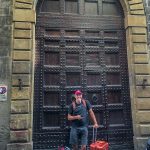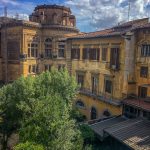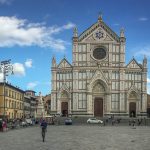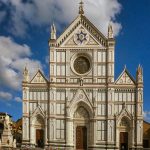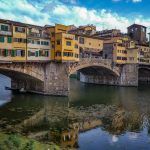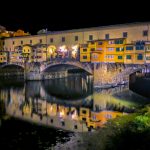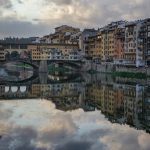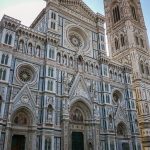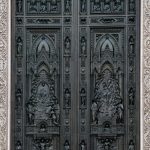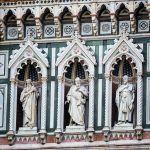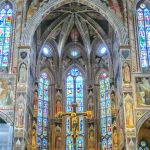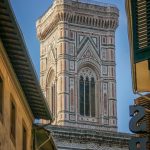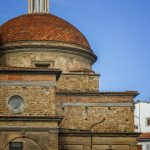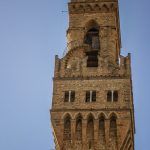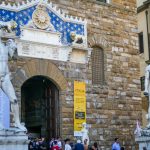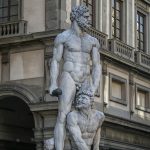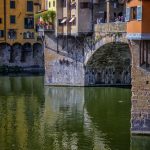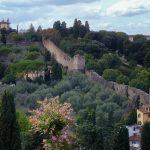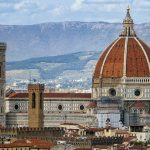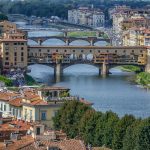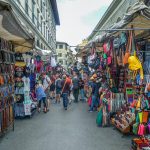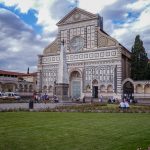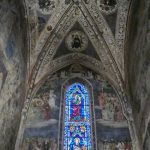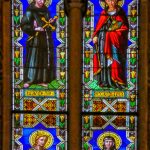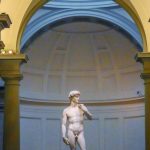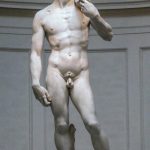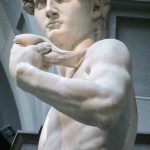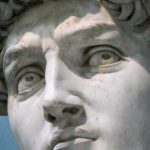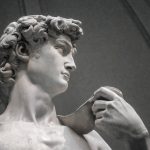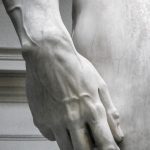 On September 13th, 2017 we took the fast train from Rome to Florence. Traveling by train from Rome to Florence is quick, easy and affordable and takes about 1 1/2 hours. We took a taxi to our Airbnb and went to explore Florence. We are staying near the Piazza di Santa Croce where we saw the Basilica di Santa Croce, the principal Franciscan church in Florence and the largest Franciscan church in the world, completed in 1385. We walked to the famous Ponte Vecchio Bridge to wander through the shops and have dinner. The Ponte Vecchio is a medieval stone closed-arch bridge over the Arno River, noted for having shops built along it. Butchers initially occupied the shops, now the present tenants are mostly jewelers, art dealers and souvenir sellers.
On September 13th, 2017 we took the fast train from Rome to Florence. Traveling by train from Rome to Florence is quick, easy and affordable and takes about 1 1/2 hours. We took a taxi to our Airbnb and went to explore Florence. We are staying near the Piazza di Santa Croce where we saw the Basilica di Santa Croce, the principal Franciscan church in Florence and the largest Franciscan church in the world, completed in 1385. We walked to the famous Ponte Vecchio Bridge to wander through the shops and have dinner. The Ponte Vecchio is a medieval stone closed-arch bridge over the Arno River, noted for having shops built along it. Butchers initially occupied the shops, now the present tenants are mostly jewelers, art dealers and souvenir sellers.
The next day we went to the the Hotel Tornabuoni to meet our guide, Simone, who was taking us on a tour of Florence. We also met Linda and Tom La Croix from Colorado who will be joining us on the VBT bike tour. We started in the center of Florence in the Piazza del Duomo, at the Florence Cathedral, formerly the Cattedrale di Santa Maria del Fiore. It was begun in 1296 in the Gothic style and was completed by 1436, with the massive dome. The exterior of the basilica is faced with beautiful marble panels in various shades of green and pink. The cathedral complex includes three buildings, and the basilica is one of Italy’s largest churches, the dome was the largest in the world , and it is still the largest brick dome ever constructed. We wanted to walk up the interior of the dome but we could not get tickets, it is so popular. Then we walked up the hill to the Piazzale Michelangelo, a square with a panoramic view of Florence. On our way back down we stopped at the Mercato Centrale, inside we browsed the various vendors selling primary ingredients of Tuscan cuisine. One more church to visit on our tour was the Basilica di Santa Maria Novella, consecrated in 1420. The facade of Santa Maria Novella was completed in 1470, and the interior of the church had beautiful stained glass windows that were made in 1492. Finally we made it to another plaza for a refreshing drink and back to our Airbnb. Click on thumbnail to view images
Statue of David
Our guide, Simone, also took us to the Galleria dell’Accademia, where the Statue of David is on display. We spent all of our time around this statue learning so much about it from Simone. David is a masterpiece sculpture created in marble between 1501 and 1504 by Michelangelo, and stands 17 feet tall. The eyes of David, with a warning glare, are turned towards Rome to protect them from the Medici family, a powerful rival of Florence.
The history of David begins before Michelangelo started working on it. In 1464 a block of marble was provided from a quarry to create a sculpture of David. The sculptor only got as far as beginning the legs, feet and the torso, and his association with the project ceased. The block of marble remained neglected for 26 years, exposed to the elements in the yard of the workshop. In 1500 the Florentine authorities were determined to find an artist who could finish this work of art. In 1501, Michelangelo was given the contract to undertake this challenging task at the age of 26. He would work on the massive statue for more than two years. The statue appears to show David after he has made the decision to fight Goliath but before the battle has actually taken place. His brow is drawn, his neck is tense and the veins bulge out of his right hand. His left hand holds a sling that is draped over his shoulder and down to his right hand, which holds a rock. Originally the statue was to be placed on the roof of the Cathedral, but it would not be possible to raise the more than six-ton statue to the roof. Hence, the figure has an unusually large head and hands (particularly apparent in the right hand) in order for the important parts of the sculpture to be visible from the ground. In 1873, the statue of David was removed from the piazza to protect it from damage, and displayed in the Accademia Gallery where it stands today. During WW II, David was entombed in brick to protect it from damage from airborne bombs. In 1991, the left foot of the statue was damaged by a mentally disturbed artist with a concealed hammer.Click on thumbnail to view images
“Michelangelo’s David has become one of the most recognized works of Renaissance sculpture, a symbol of strength and youthful beauty.”


